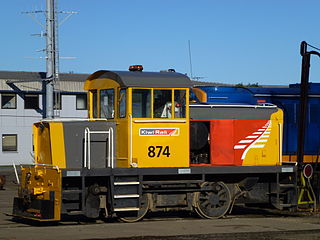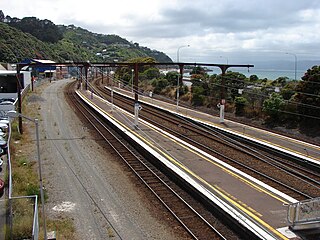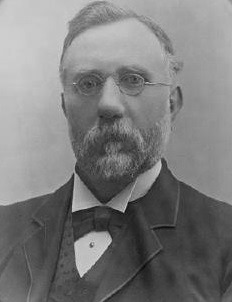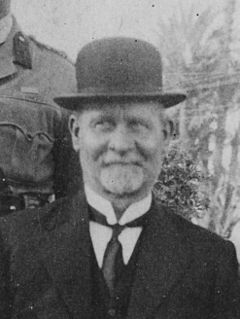
William Foster & Co Ltd was an agricultural machinery company based in Lincoln, Lincolnshire, England often called "Fosters of Lincoln." The company can be traced back to 1846, when William Foster purchased a flour mill in Lincoln. William Foster then proceeded to start small scale manufacturing of mill machinery and threshing machinery. The mill was converted to an iron foundry by 1856, thus becoming the original Wellington Foundry. By 1899 the works had moved to the Wellington foundry in New Boultham and the original works were then occupied by William Rainforth. During the First World War Fosters built some of the first tanks for the British Army.

The NZR A class of 1873 consisted of three types of steam locomotives used on New Zealand's railway network of similar specification but differing detail. The first and most numerous were from the Dübs and Company, the next from the Wellington firm E.W. Mills Lion Foundry, and the last from the Scottish firm of Shanks. The specifications are for the Dubs Yorkshire engines.
Locomotives of New Zealand is a complete list of all locomotive classes that operate or have operated in New Zealand's railway network. It does not include locomotives used on bush tramways.

The 8.38 miles (13.49 km) Tawa Flat deviation is a double-track section of the Kapiti Line just north of Wellington, New Zealand with two tunnels; the southernmost section of the North Island Main Trunk railway (NIMT) between Wellington and Auckland. It was built to bypass a limited capacity single track section of the original Wellington and Manawatu Railway (WMR) line which ascended from Wellington to Johnsonville and then descended to Tawa Flat. The original name of Tawa Flat was changed to Tawa in 1959.

The Wellington Urban Motorway, part of SH 1, is the major road into and out of Wellington, New Zealand. It is 7 km long, ranges from three to seven lanes wide, and extends from the base of the Ngauranga Gorge into the Wellington CBD.

The New Zealand TR class locomotive is a type of diesel shunting locomotives built by many different manufacturers. Defined as "shunting tractors" or "rail tractors" by KiwiRail and its predecessors, they are classified "TR" for tractor as a result. Many of these locomotives have been withdrawn, but some are still in service. The first locomotive of this class was built by NZR in 1924. The most powerful were Japanese-built Hitachi TRs, with 138kW Cummins engines.

Kaiwharawhara railway station, a former railway station on the North Island Main Trunk and the Wairarapa Line in Wellington in New Zealand, closed in 2013. It was the first station north of Wellington, serving the early suburb of Kaiwharawhara. Prior to its closure it was served by trains operated by Tranz Metro as part of the Metlink network on the Melling Line, the Hutt Valley Line and the Kapiti Line.

Kaiwharawhara is an urban seaside suburb of Wellington in New Zealand's North Island. It is located north of the centre of the city on the western shore of Wellington Harbour, where the Kaiwharawhara Stream reaches the sea from its headwaters in Karori. It is a largely commercial and industrial area and thus has little residential population. A recent housing development up the hillside towards Te Kainga has increased the resident population.

Joseph Dransfield was the first mayor of Wellington, New Zealand, from 1870 to 1872. He was the first mayor since William Guyton was (briefly) mayor of Wellington Borough in 1843.

Thomas William Hislop was the Mayor of Wellington from 1905 to 1908, and had represented two South Island electorates in the New Zealand Parliament.

John Rutherford Blair was the Mayor of Wellington, New Zealand from 1898 to 1899.

A & G Price was an engineering firm and locomotive manufacturer in Thames, New Zealand, from 1868. A few months short of 150 years after it was founded its then owner was put into liquidation on 26 July 2017. About 100 employees lost their jobs.

Scott Brothers Limited was an engineering firm in Christchurch, New Zealand.
Wellington, was a parliamentary electorate in Wellington, New Zealand. It existed from 1853 to 1905 with a break in the 1880s. It was a multi-member electorate. The electorate was represented, over the years, by 24 members of parliament.

Richard McCallum was a Liberal Party Member of Parliament in New Zealand, and later a member of the Legislative Council. A barrister from Blenheim, he held many local positions, including two years as Mayor of Blenheim. One of his main interests was the advancement of education.
Nathaniel Edwards MLC was a 19th-century Member of Parliament from Nelson, New Zealand.

Perry Engineering was a major foundry and steel engineering works in the state of South Australia.

Jas J Niven & Co Limited later Niven Engineering, was a New Zealand engineering business based in Wellington with operations throughout the country. The foundry that became Niven's business was established in Napier in 1866.

The Kokiri Tramway was at least from 1895 to the 1902 a bush tramway with a gauge of 1,067 mm near Kokiri on the Arnold River in the west of New Zealand's South Island.

The Mountain Rimu Timber Company owned and operated a bush tramway near Mamaku, south of the Kaimai Range near Rotorua in the Bay of Plenty Region of the North Island of New Zealand. The tramway, with a track gauge of 3+1⁄2 feet (1,067 mm), was used from approximately 1898, to at least 1935.
















